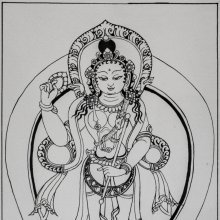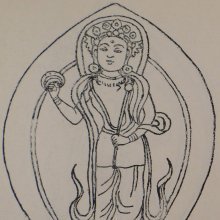Vishnucakra, Viṣṇucakra, Vishnu-cakra: 7 definitions
Introduction:
Vishnucakra means something in Buddhism, Pali, Hinduism, Sanskrit. If you want to know the exact meaning, history, etymology or English translation of this term then check out the descriptions on this page. Add your comment or reference to a book if you want to contribute to this summary article.
The Sanskrit term Viṣṇucakra can be transliterated into English as Visnucakra or Vishnucakra, using the IAST transliteration scheme (?).
Alternative spellings of this word include Vishnuchakra.
Images (photo gallery)
In Hinduism
Purana and Itihasa (epic history)
Source: archive.org: Shiva Purana - English TranslationViṣṇucakra (विष्णुचक्र) is the second of the five divisions of the Kālacakra (wheel of time), as defined in the Śivapurāṇa 1.17. Accordingly, “The Kālacakra consists of five wheels, one being over the other: [...] (2) Enjoyment and delusion (bhoga and moha) constitute the Viṣṇucakra [...]. Thus scholars have explained the five cakras”.

The Purana (पुराण, purāṇas) refers to Sanskrit literature preserving ancient India’s vast cultural history, including historical legends, religious ceremonies, various arts and sciences. The eighteen mahapuranas total over 400,000 shlokas (metrical couplets) and date to at least several centuries BCE.
In Buddhism
Tibetan Buddhism (Vajrayana or tantric Buddhism)
Source: archive.org: The Indian Buddhist IconographyViṣṇucakra (विष्णुचक्र) or Viṣṇucakralokeśvara refers to number 97 of the 108 forms of Avalokiteśvara found in the Machhandar Vahal (Kathmanu, Nepal). [Machhandar or Machandar is another name for for Matsyendra.].
Accordingly,—
“Viṣṇucakra is similar to [Piṇḍapātra Lokeśvara], except that here he holds the Cakra in his right hand and the Gadā in his left.—Piṇḍapātra Lokeśvara is one-faced and two-armed and stands on a lotus. He holds the Piṇḍapātra (the bowl) in his two hands near the navel”.
The names of the 108 deities [viz., Viṣṇucakra] possbily originate from a Tantra included in the Kagyur which is named “the 108 names of Avalokiteshvara”, however it is not yet certain that this is the source for the Nepali descriptions. Tibetan Buddhism includes schools such as Nyingma, Kadampa, Kagyu and Gelug. Their primary canon of literature is divided in two broad categories: The Kangyur, which consists of Buddha’s words, and the Tengyur, which includes commentaries from various sources. Esotericism and tantra techniques (vajrayāna) are collected indepently.
Mahayana (major branch of Buddhism)
Source: De Gruyter: A Buddhist Ritual Manual on AgricultureViṣṇucakra (विष्णुचक्र) refers to “Viṣṇu’s discus” (according to the Jvalitavajrāśanituṇḍā-dhāraṇī) [i.e., bhara bhara viṣṇucakrahastam], according to the Vajratuṇḍasamayakalparāja, an ancient Buddhist ritual manual on agriculture from the 5th-century (or earlier), containing various instructions for the Sangha to provide agriculture-related services to laypeople including rain-making, weather control and crop protection.

Mahayana (महायान, mahāyāna) is a major branch of Buddhism focusing on the path of a Bodhisattva (spiritual aspirants/ enlightened beings). Extant literature is vast and primarely composed in the Sanskrit language. There are many sūtras of which some of the earliest are the various Prajñāpāramitā sūtras.
Languages of India and abroad
Sanskrit dictionary
Source: Cologne Digital Sanskrit Dictionaries: Cappeller Sanskrit-English DictionaryViṣṇucakra (विष्णुचक्र).—[neuter] the discus of Viṣṇu.
Source: Cologne Digital Sanskrit Dictionaries: Monier-Williams Sanskrit-English Dictionary1) Viṣṇucakra (विष्णुचक्र):—[=viṣṇu-cakra] [from viṣṇu] n. Viṣṇu’s discus, [Rāmāyaṇa]
2) [v.s. ...] a [particular] mystical circle (formed from the lines in the hand), [Viṣṇu-purāṇa]
[Sanskrit to German]
Sanskrit, also spelled संस्कृतम् (saṃskṛtam), is an ancient language of India commonly seen as the grandmother of the Indo-European language family (even English!). Closely allied with Prakrit and Pali, Sanskrit is more exhaustive in both grammar and terms and has the most extensive collection of literature in the world, greatly surpassing its sister-languages Greek and Latin.
Kannada-English dictionary
Source: Alar: Kannada-English corpusViṣṇucakra (ವಿಷ್ಣುಚಕ್ರ):—
1) [noun] the circular weapon of Viṣṇu.
2) [noun] a kind of firework that rotates around a pin, when lit.
3) [noun] (palm.) an almost circular figure formed by several lines in the last digits of the fingers in the hand.
Kannada is a Dravidian language (as opposed to the Indo-European language family) mainly spoken in the southwestern region of India.
See also (Relevant definitions)
Partial matches: Vishnu, Cakra.
Starts with: Vishnucakralokeshvara, Vishnucakravarti.
Full-text: Vishnupura, Caturvaktra-Surya, Vishnucakralokeshvara, Astra, Mantramayarakshanirupana, Kalacakra, Mantramaya, Arjuna, Bhram.
Relevant text
Search found 8 books and stories containing Vishnucakra, Viṣṇucakra, Vishnu-cakra, Viṣṇu-cakra, Visnucakra, Visnu-cakra; (plurals include: Vishnucakras, Viṣṇucakras, cakras, Visnucakras). You can also click to the full overview containing English textual excerpts. Below are direct links for the most relevant articles:
The Indian Buddhist Iconography (by Benoytosh Bhattachacharyya)
Nitiprakasika (Critical Analysis) (by S. Anusha)
Sahitya-kaumudi by Baladeva Vidyabhushana (by Gaurapada Dāsa)
Text 8.21 < [Chapter 8 - Literary Qualities]
Ramayana (by Manmatha Nath Dutt)
Chaitanya Bhagavata (by Bhumipati Dāsa)
Verse 3.2.145 < [Chapter 2 - Description of the Lord’s Travel Through Bhuvaneśvara and Other Placesto Jagannātha Purī]
Puranic encyclopaedia (by Vettam Mani)

